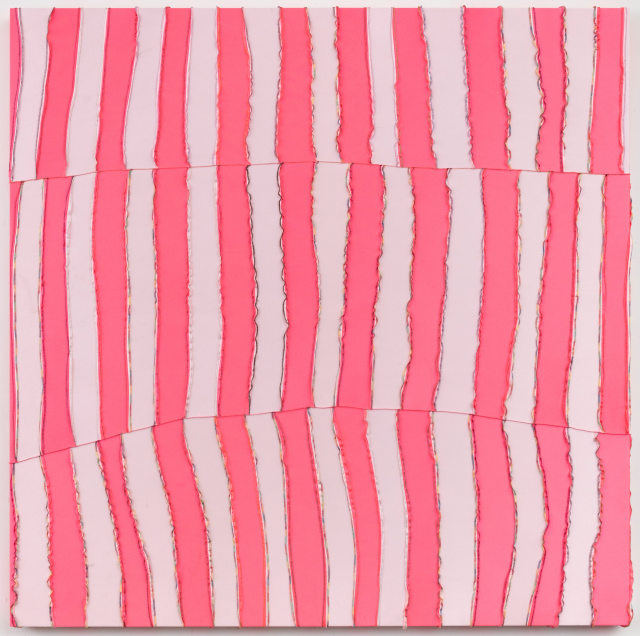CARBON 12 is pleased to present new works by Anthony Olubunmi Akinbola, Bernhard Buhmann, Anahita Razmi, Nour Malas, with careful interventions with Monika Grabischnigg’s fridge compartments. The booth forges a discourse between these artists’ practice, exhibiting new works that are intrinsically linked to their overall practices, each of which investigating an ongoing tension between abstraction and figuration, and materiality and form as is carried throughout the differing approaches to their respective practices.
Anahita Razmi (b. 1981, Germany) uses various symbolism throughout her work and tests their meaning beyond context, translating, re-staging or blending them into new environments. The artist encourages viewers to reconsider the significance we attach to the symbols that represent nations within broader environmental and social contexts. Razmi explores this use of symbolism to challenge the traditional contexts and disrupts the conventional understanding of clear boundaries and standardization associated with symbols of national representation. The artist also uses these symbols to present political yet mildly absurd proposals prompting viewers to critically examine the power dynamics and narratives associated with them.
Bernhard Buhmann’s (b. 1979, Austria) intensely chromatic compositions walk a fine line between abstraction and figuration. His works recall historical tradition and the contemporary condition to question identity and contemplate the consequences of technology from both a social and individual level in the event of when shared information is misconstrued. Exploring a new square format, the artist offers a perspective that highlights the sensitive mirrors of the stages of everyday life, while simultaneously questioning the reconstruction of identity.
Anthony Olubunmi Akinbola (b. 1991, USA) unravels the contexts which define culturally specific, ready-made objects, such as the Durag, and makes known their purpose in the care and maintenance of Black hair. While largely defined by their popularity within African communities, the CAMOUFLAGE series explores other threads within this larger topic; highlighting a commentary on global consumption, and the circumstances which continually reinforce structures of capitalism. The artist further explores themes of the consumption and commodification of Black culture.
Monika Grabuschnigg’s (b.1987, Austria), works reference grasps the space between life and death, through a melancholic perspective. Utilizing the primitive and tactile material of clay in opposition to the digital age, Grabuschnigg focuses on motifs of philosophy, memory, dream as well as popular culture. The artist primarily explores how external forces shape the values, beliefs and desires that create the fundamental understanding of us, as human beings. Her wreaths, referencing the nightshade berries, a highly poisonous yet seductive-looking fruit, represent the first time the notions of danger and fear came into the artist’s life.
Nour Malas’s (b.1995, France) series of small paintings on wood panel continue her explorations of transient emotions and the in- between. Malas’s gestural, bold, and expressive brushstrokes give the paintings an almost sculptural sense. Falling within the link of past and present, the compositions depict subtly moving figures within layers that exist between dream and reality. Using light and darkness to highlight these figures, and relying on the immediacy of painting, she explores the automation of memories appearing.
Each artist offers contrasting representations and various processes of portraying their introspections, the basis of transformation and fundamental understanding of the world around them. Relating to themes of modern and contemporary culture, the respect for the natural world, and how we as humans continue to live our lives in the present with regards to emotions, remains intertwined within their overarching bodies of work.




